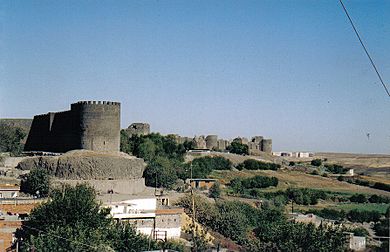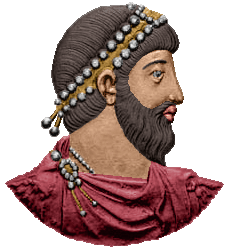Ammianus Marcellinus facts for kids
Quick facts for kids
Ammianus Marcellinus
|
|
|---|---|
| Born | c. 330 |
| Died | c. 391–400 |
| Nationality | Roman |
| Occupation | Historian and soldier |
|
Notable work
|
Res gestae |
Ammianus Marcellinus was a Roman soldier and historian. He lived a long time ago, from about 330 AD to 400 AD. He wrote an important history book called Res gestae. This book tells the story of the Roman Empire. It covers the years from 96 AD to 378 AD. However, only the parts about the years 353 to 378 still exist today.
Contents
Ammianus's Life Story

Ammianus was born around 330 AD. He was likely born in the eastern part of the Roman Empire. This might have been in Syria or Phoenicia. We don't know his first language. But he probably spoke both Greek and Latin.
Becoming a Soldier
Ammianus joined the Roman army when he was young. He became an officer. He served under two important emperors: Constantius II and Julian. He was part of an elite group called protectores domestici. These were special household guards. This shows he came from a good family.
He first served in the East under a general named Ursicinus. Ursicinus was a magister militum, a top military commander. Ammianus went on two campaigns with him in the East.
Adventures in Gaul and the East
Ammianus traveled to Italy with Ursicinus. They went to stop a general named Silvanus. Silvanus had been forced to declare himself emperor in Gaul. Ursicinus had Silvanus killed. This brought Gaul back under the emperor's control.
Ammianus probably met Emperor Julian in Gaul. Julian later became the emperor. In 359 AD, Ammianus returned to the East. He helped defend against an invasion by the Persian king Shapur II. Ammianus was a good scout. He found the main Persian army. He reported this to his commander.
Ammianus was in the city of Amida when the Persians attacked it. He barely escaped with his life when the city fell. After this, Ammianus seems to have left the army for a short time. But some historians think he kept serving.
He later joined Emperor Julian's campaigns. He fought against the Alamanni and the Persians. Ammianus greatly admired Julian. After Julian died, Ammianus went with the new emperor, Jovian, to Antioch.
Life as a Historian
Ammianus eventually settled in Rome. This is where he started writing his big history book, Res gestae. We don't know exactly when he died. Most experts think it was between 392 and 400 AD.
Ammianus was a pagan. This means he followed the old Roman gods. But he was also fair to Christians. He wrote that Christianity was a "plain and simple" religion. He criticized Christians when they fought among themselves. He also criticized Emperor Julian for being too focused on pagan sacrifices.
Ammianus's Important Book
Ammianus wrote his history book, Res gestae, in the 380s. It was written in Latin. It continued the history written by another famous historian, Tacitus. Ammianus's book covered the Roman Empire from 96 AD to 378 AD. He probably finished it before 391 AD.
What is Res gestae?
The full title of his work was Rerum gestarum libri XXXI. This means "Thirty-one Books of Deeds". It originally had 31 books. But the first 13 books are now lost. The 18 books that still exist cover the years 353 to 378 AD.
This book is very important for understanding the Roman Empire in the 300s AD. Many people praise it. They say it is a clear and fair account of events. Ammianus tried to be fair. But like many ancient historians, he did have his own opinions.
How the Book Survived
The book has faced some challenges over time. Besides the lost parts, the remaining books have some missing words or errors. This happened as copies were made by hand.
The main copy we have today was made in the 800s. It was copied from an older text. There is also another small part of a copy from the 800s. These old copies helped scholars put together the book we read today.
The first printed version of parts of the book came out in 1474. The first complete version of the surviving books was printed in 1533. Later, the first modern edition was published in 1910-1913. The first English translations came out in 1609 and 1862.
See also
 In Spanish: Amiano Marcelino para niños
In Spanish: Amiano Marcelino para niños




